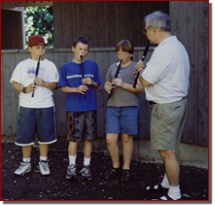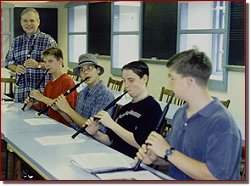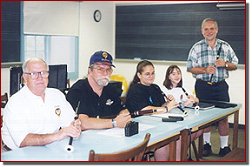

|
|
Get the latest news and info:
|
|

So You Want to Learn to Play the Pipes If you are interested in learning how to play the bagpipe, I am available for private lessons at my home (Calliope House), 1414 Pennsylvania Avenue, on Pittsburgh’s North Side, as well as small group classes offered through Calliope, The Pittsburgh Folk Music Society. Group classes are held at Chatham College. I teach Monday through Thursday evenings, at 6:30pm and 7:30pm. Having studied for decades with traditional piping masters of Scotland and Ireland, I use traditional methods of teaching combined with more modern approaches to music education. Some of the students I have started from scratch have met with considerable success on amateur competition platforms. An additional option for bagpipe students is to attend an intensive one week or more summer session of the Balmoral School of Piping, which I founded in 1978 with bagpiping Gold Medalist James McIntosh. This summer we are producing five sessions at colleges or conferences centers in CA, PA, KY, and IL. For more information about the Balmoral School of Piping, click here. 
If you are interested in becoming a beginning student, I would like to briefly describe what you will get yourself into when learning this ancient and fascinating instrument. First of all, I must point out that it is not a particularly easy instrument to play. However, I believe that anyone can learn to play the pipes who has the following: A) self-motivation, B) the ability to count steadily, C) a minimum of 30 minutes a day of practice, and D) a good teacher. One begins his or her learning of the pipes with a quiet instrument called the practice chanter. This instrument is what all pipers learn on, whether a beginner just getting control of the fingers or an advanced player learning new tunes or refining existing tunes. As with the pipes themselves, it is a reed instrument, and has the same number of finger holes as the melody pipe or chanter of the bagpipes. However, you blow directly into the practice chanter rather than into a bag, and the volume is much, much less. In other words, we can quietly learn the correct fingering of pipe music without blowing hard and making a lot of terrible noises. I also need to point out that the fingering itself is specialized, and unique to the instrument. It is highly advisable for learners to work with a qualified instructor. Otherwise it is easy to pick up bad habits, making it impossible to play good music. 
After the student has memorized about 5 or 6 tunes on the practice chanter, and plays them correctly, the time is reached to start making the transition to the pipes. This is usually after 3-6 months of weekly or biweekly lessons on the practice chanter. The reason for the delay in starting on the great pipes is because there are so many other things besides moving the fingers that must be done, such as blowing harder, squeezing the bag, and coordinating these two activities so that the pressure of one equals the pressure of the other. The beginner has too many things to do at once if he or she is trying to learn the music at the same time as these other functions. The practice chanter allows us to control our fingers and learn the music first, before we try to co-ordinate the squeezing and blowing needed for the bagpipes. In summary, wisdom dictates that for best results we must learn one thing at a time, a proposition that is true not only for bagpipes but for most endeavors. 
A major feature of the practice chanter is that it represents much less of an investment than the Great Highland pipes: between $80 and $175, depending on the quality of the materials used in its construction (i.e. Delrin, a synthetic, dense material vs. African Blackwood or Grenadilla, the wood from which other expensive woodwinds like oboes or bassoons are constructed). So the cost of your chanter of choice coupled with $15 or so for an instruction book is what is needed to start lessons. Full sets of new pipes start at $850, although occasionally used sets can be found for less. Usually the purchase of a set of pipes is made with the assistance of a teacher. Beware of cheap sets made of inferior materials. Most of these can be identified by their weight and inferior craftsmanship: they are a lot lighter in weight than the sets made of quality materials, and you can identify shoddy craftsmanship by examining the inside of the drone and chanter bores for unpolished roughness. I hope this information has been helpful. If you have additional questions please contact me and I shall be glad to be of assistance. |